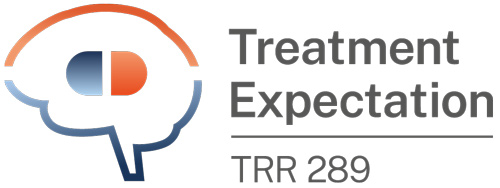EEG (electroencephalography) measurement of brainwaves shows which areas of the brain process and modulate pain. © romaset/stock.adobe.com
EEG (electroencephalography) measurement of brainwaves shows which areas of the brain process and modulate pain. © romaset/stock.adobe.com
What happens before we feel pain – and what do emotions and control have to do with this?
Are we able to see pain even before it develops? In Project A03, we are using imaging techniques to investigate what happens in our brains when we are expecting a painful stimulus, or relief from a painful stimulus. In the first funding period of our Collaborative Research Centre, we developed an experimental approach through which we were not only able to demonstrate these expectations but were even able to influence them. Indeed, we managed to do this so precisely that we were able to use the expectation patterns in the brain to predict, with something close to certainty, how our study participants would feel the subsequent pain.
Self-efficacy and emotions are hugely important
In the second funding period, we now want to look in more detail at how two key factors influencing expectations affect brain activity: the emotional context and self-efficacy. It is known that treatment success is strongly influenced by patients’ general mood and how they are feeling in a given treatment situation. It is also influenced by whether patients feel that they are able to influence the situation themselves – or whether they think that they’re at its mercy. As such, both of these factors are highly important for everyday medical practice.
A brain-computer interface enables neurofeedback
In Project A03, we use data from functional magnetic resonance imaging (fMRI), from skin conductance measures (electrodermal activity, EDA), and from electroencephalography (EEG). Using EEG, we are able to set up a brain-computer interface (BCI), in which participants’ brain activity is processed live on a computer and shown on a monitor. In this way, the participants can see their own brain activity and learn to influence it. This method is called neurofeedback, and it is also used in Project A03.
Studying feelings in virtual reality
The findings from these experiments should help us to better understand how expectations develop in the brain, how they affect actual feelings, and how they can be influenced. To examine the effect of positive and negative feelings in more detail, virtual reality (VR) is used. How are emotions and expectations linked to each other? And do changed expectations also have consequences for other areas in which we deal with feelings? Project A03 also addresses these questions.
Rose M, Haider H, Salari N, Büchel C (2011) Functional Dissociation of Hippocampal Mechanism during Implicit Learning Based on the Domain of Associations. J Neurosci 31(39):13739-45. PubMed
Salari N, Rose M (2016) Dissociation of the functional relevance of different pre- stimulus oscillatory activity for memory formation. NeuroImage S1053-8119(15)00948-9. PubMed
Salari N, Rose M (2014) Neurofeedback training of gamma band oscillations improves perceptual processing. Exp Brain Res 232(10):3353-61. PubMed
Taesler P, Rose M (2016) Pre-stimulus theta oscillations and connectivity modulate pain perception. J Neurosci 36(18): 5026-5033. PubMed
In close cooperation with these projects
How we create our own expectations – and the role that attention plays in this
Prof. Dr. Christian Büchel
How expectations influence stomach ache – and how the experience of pain changes treatment expectations
Prof. Dr. Sigrid Elsenbruch
PD Dr. Julian Kleine-Borgmann
How do expectations control our emotions - and what does attention have to do with it?
Prof. Dr. Stefanie Brassen
Project Lead

Prof. Dr. Michael Rose
Psychologist
Team
Sebastian Heeren
PhD student, Psychologist
Leonie Lambertz
PhD student, Psychologist
Christoph Wittkamp
Psychologist
Maren-Isabel Wolf
Psychologist



